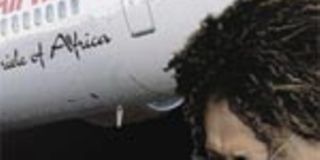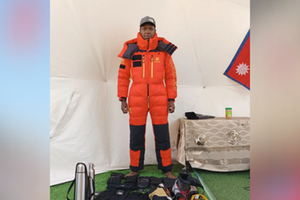Disaster at midnight: 114 people feared dead in Kenya Airways plane accident

A Kenya Airways jetliner with 114 passengers on board crashed in a densely forested area of southern Cameroon on Friday night shortly after takeoff.

The Kenya Airways Nairobi to Abidjan flight route. The ill-fated plane lost contact with air traffic controllers shortly after takeoff at midnight.
Kenya Airways Managing Director Titus Naikuni said the Boeing 737-800 lost contact with air traffic controllers shortly after takeoff at midnight. It had been expected to land in Nairobi at 6.15 am yesterday.
The last contact with the aircraft was an electronic signal received about 13 minutes after takeoff and there had been no verbal communication with the crew after takeoff, Mr Naikuni said during a news conference in Nairobi.
Among the passengers were nine Kenyans, all crew members.
The nationalities of the other passengers were given as 35 Cameroonians, 15 Indians, seven South Africans, six each from China, Cote d’Ivoire and Nigeria, five Britons, and three Nigerians.
Also on the flight were two people from Central African Republic, two from the Democratic Republic of Congo and Equitorial Guinea, one each from Switzerland, Mali, Togo, Sweden, Ghana, Comoros, Mauritius, Senegal, Congo Brazaville, Egypt, Tanzania, Burkina Faso and the USA.
The nationality of three other passengers had not been established because they booked online.
Among the passengers were three referees from Cameroon who were transiting in Nairobi en route to DR Congo for an Africa Confederation Cup match between home team TPS Mazembe and Zimbabwe’s Mwana Africa.
According to a Xinhua report, there were six Chinese on the plane.
And a China.com.cn report cited a Chinese embassy official in Cameroon as saying that two of the Chinese had been identified as Liu Sheng and Wu Changgen, both in their 30s.
Liu was from Huawei company and Wu from a Jiangsu company based in Cameroon.
The embassy has dispatched five people to the site to help identify the Chinese and deal with the emergency, and the Chinese companies stationed there also sent people to the site.
The plane was also carrying the general manager of Cameroon mobile telephone operator MTN, Mr Newton Campbel, a South African. He was with the head of MTN technical department and her husband (all South Africans) and the head of legal affairs.
There were 50 businessmen from Douala’s Central Market heading for China. A Cameroonian journalist reporting for the Nation Media Group from Douala, Mr Chi Arnest Cho, described the market as resembling a graveyard.
“Everybody is like a bereaved person,” said Mr Chi.
A Cameroon government official in the town said local people had reported seeing wreckage of a plane at Melakat to the south of the country about 250 km from Douala.
Others who were thought to be on the plane included a staff member of the Associated Press news organisation, Mr Anthony Mitchell, who was returning to Nairobi after a three-month assignment in West Africa and a popular Nigerian televangelist who had telephoned people in Nairobi to say he was boarding the plane.
There was also 27-year-old Ouandji Pierre, the son of the Secretary General of Shelter Afrique, Mr Louis Roger Ouandji.
Military and civil aviation helicopters were scouring a wide zone in the Central African country between Kribi on the Atlantic coast and Ngomedzap, south of the capital Yaounde.
“The search is under way but the accident site has not yet been found,” the Transport ministry said in a statement.
State radio earlier reported the plane crashed near Nieté, north of the border with Equatorial Guinea, after taking off from Cameroon’s second city of Douala.
“We were not able to locate any wreckage at Nieté where first information suggested the crash may have occurred,” a local government official in southern Cameroon told Reuters.
He said the search had shifted to another area southwest of the capital — between the towns of Lolodorf and Ebolowa — where inhabitants said they had heard a loud explosion.
In Nairobi, Mr Titus Naikuni said authorities in Cameroon had picked up an automatic distress signal from the area where the plane went missing.
“The distress signal came from a machine, not a pilot,” he said.
The company said the Douala control tower had received the last message from the aircraft right after takeoff.
Satellite images
Kenyan Transport Minister Chirau Ali Mwakwere said the US government was assisting in the search with satellite images taken over the expected flight path.
Kenya Airways, one of Africa’s few profitable carriers, set up a crisis centre to monitor events and a passenger information centre at a hotel in Nairobi.
The carrier generally has a good safety record on a continent where air accidents are above the world average.
The plane was six months old and had no history of problems, Mr Naikuni said. It was reported to have been raining in Douala when the plane took off.
On January 30, 2000, a Kenya Airways Airbus A-310 crashed into the sea shortly after takeoff from Abidjan, killing 169 of the 179 passengers and crew.
Kenya Airways set up trauma centres at the company headquarters at Embakasi, Inter- Continental Hotel and Panari Sky Centre
Clinical Psychologist Dr Sobie Mulindi and Psychiatrist Dr Frank Njenga were manning the centres.




